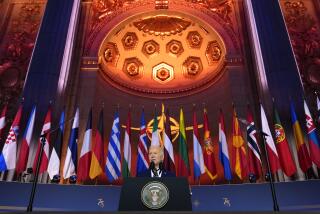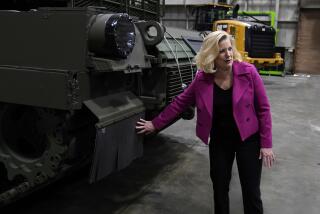NEWS ANALYSIS : Allies Alter Treaty to Save It, Letting Russia Keep More Tanks on Borders
MOSCOW â Making a virtue of necessity, the United States and its European allies have eased the terms of a vital arms control agreement to allow Russia to be in compliance, preventing the treaty from falling into tatters.
The Kremlin has complained for more than two years that the Conventional Forces in Europe accord imposes intolerable limits on the numbers of tanks and artillery pieces Russia can deploy in its border regions.
With a Nov. 17 deadline looming for CFE compliance and the nearly 10-month-old war in Chechnya putting pressure on Moscow to maintain its military muscle in the fractious southern region, Russiaâs longstanding concerns have escalated into an outright refusal to make concessions.
But rather than let the important disarmament accord unravel, officials of the 16-nation North Atlantic Treaty Organization say they have offered to redefine some border regions, effectively legitimizing the status quo.
At a conventional forces consulting group conference in Vienna over the past week, NATO offered to reclassify several zones where Russian forces exceed CFE limits from âflank regionsâ to ârear areas,â which would allow the disputed hardware to remain in place.
NATO also appeared ready to make a similar gesture toward Ukraine, which wants to keep all 786 tanks it has deployed in the strategically sensitive Odessa military district. CFE provisions limit tanks in that flank to 680.
An official agreement among CFE signatories to reclassify the disputed districts is not yet final, but Russian and Ukrainian political analysts believe that the NATO proposal has already placated the resistant governments. And by accommodating the two nationsâ opposition to reducing their military presence in the flank areas, the observers say, the Western allies have salvaged an arms control agreement that is considered a security cornerstone of the new Europe.
But the search for what U.S. and European diplomats euphemistically refer to as âwiggle roomâ in the CFE treaty may also have signaled to the Kremlin that the West values an atmosphere of amity more than it does the disarmament measures mandated by the agreement.
*
Further, the Westâs bow to Russian insistence on keeping a huge armed presence along its southern flank as it quashes Chechnyaâs secession âmay be viewed as Western acquiescence in Russian punitive expeditions,â the Prague-based Radio Free Europe/Radio Liberty news service stated.
Some Western analysts express concern that relaxing the terms of the CFE accord to sidestep another crisis in wobbly U.S.-Russian relations sets a dangerous precedent that may undermine the cause of implementing other arms control agreements.
âThis is a serious and important issue because it goes to the sanctity of international commitments Russia inherited as the successor state to the Soviet Union,â said a senior U.S. official on Moscowâs unabashed intention to violate the CFE treatyâs flank limitations.
President Clinton had insisted during his summit with President Boris N. Yeltsin here in May that Russia meet the weapons-reduction terms of the treaty by the November deadline and address any requests for adjustment to a review conference next spring. But as it became clear Russia would make no move to reduce its armored forces in the North Caucasus flank, where rebellious Chechnya and other ethnic flash points are located, NATO officials re-evaluated the implications of noncompliance.
While defense officials grumble that Russia strong-armed its fellow CFE signatories into legitimizing the excess weapons, political analysts and arms negotiators argue Russia has valid concerns about its security and that to hold it to the letter of an agreement negotiated during the Cold War could inflict more damage to European stability than would the surplus of conventional weapons.
*
âQuite frankly, the Russians have a good point that conditions have changed drastically since the treaty was signed,â said a political attache from a NATO country. âThis treaty was drawn up for a Europe that no longer exists.â
Russia remains committed to staying under the overall limit of 6,400 tanks in the European region west of the Ural Mountains, a factor of far greater significance than its conformance with limits for any one flank region, said Alexander A. Konovalov, a defense policy analyst at Moscowâs U.S.A.-Canada Institute.
âIf in November, Russia were to be proclaimed a violator, the result would be the complete destruction of the treaty,â Konovalov stated. âI donât consider what is happening a renegotiation of the treaty. This is a necessary adjustment of the existing treaty.â
*
Vyacheslav A. Nikonov, chairman of the International Security and Arms Control Committee of the Duma, the lower house of Parliament, argues that the West only gains by giving Russia breathing space on the flank limits. The treaty is preserved, a disruptive diplomatic confrontation is avoided and Western allies appear more sympathetic to Russian sensitivities about defense capability on the vulnerable southern border, he said.
âWhat is good here is that NATO shows that it understands Russiaâs concern over this issue and is willing to compromise,â Nikonov said.
The negotiated flank limits would have required Russia to withdraw all but 700 tanks, 580 other armored vehicles and 1,280 artillery pieces of a caliber greater than 100 millimeters--a deployment strength analysts say is exceeded in the North Caucasus region alone.
Russia now has 3,000 tanks, 5,500 armored vehicles and 3,000 artillery pieces in its flank regions, according to the U.S. Arms Control and Disarmament Agency.
With a shaky cease-fire unraveling in Chechnya and elections to the Duma set for December, the diplomats and analysts say they feared that Western insistence on strict adherence to the flank limits would have alienated Russian public opinion, scuttled the CFE treaty and added further heat to an already incendiary debate over NATO expansion and alliance policy in the war-torn Balkans.
Turning a blind eye to amassed armor backing the Russian troops deployed in Chechnya is a small price to pay, the observers argue, to prevent the issue of arms control from becoming an election-year political football.
Times staff writer Tyler Marshall in Brussels and Times special correspondent Mary Mycio in Kiev contributed to this report.
(BEGIN TEXT OF INFOBOX / INFOGRAPHIC)
BACKGROUND
The 1990 Conventional Forces in Europe agreement was intended to reduce the firepower on both sides of the Cold War confrontation line that ran through divided Germany and between Eastern and Western Europe. Russiaâs military withdrawal from the former Warsaw Pact states and now-independent Baltic nations rendered the main objectives of the CFE treaty moot, leaving only general weapons ceilings and flank limitations as effective measures of compliance.
More to Read
Sign up for Essential California
The most important California stories and recommendations in your inbox every morning.
You may occasionally receive promotional content from the Los Angeles Times.











